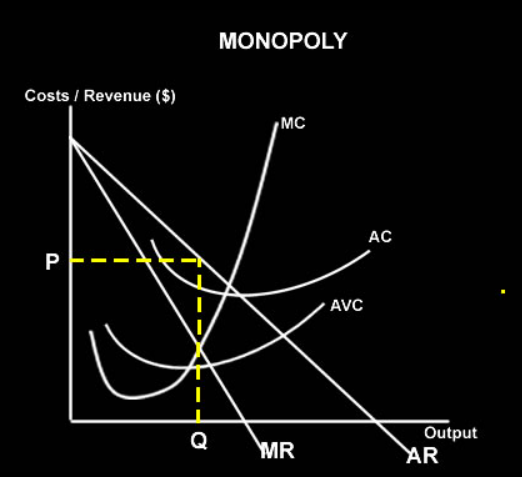In a monopoly, the total costs terms remain the same. The Per Unit Costs scenario changes
A monopoly is a market structure where a single firm is the sole seller of a product with no close substitutes. Because the monopolist controls the entire market, it has price-setting power.
The monopolist determines the profit-maximizing level of output where:
MR = MC
This is the golden rule for profit maximization in all market structures, including monopoly.
After choosing the output level where MR = MC, the monopolist charges the highest price consumers are willing to pay, which lies on the demand curve (AR curve).
🔍 Profit Conditions in a Monopoly
Once the profit-maximizing output is set (MR = MC), the nature of the firm’s profit is determined by comparing AR (Price) to AC at that output level:
1. ✅ If AR > AC → Abnormal (Supernormal) Profit
-
Price per unit > Cost per unit
-
The firm earns profit above normal.
-
Common for monopolies due to lack of competition.
-
Graphically: AR curve lies above the AC curve at the chosen output.
2. ⚖️ If AR = AC → Normal Profit
-
Price per unit = Cost per unit
-
The firm covers all its costs, including opportunity cost of capital.
-
It breaks even, earning just enough to stay in business.
-
Graphically: AR curve touches the AC curve at the chosen output.
3. ❌ If AR < AC → Loss
-
Price per unit < Cost per unit
-
The firm incurs a loss.
-
A monopolist may still operate in the short run if it covers average variable costs.
-
Graphically: AR curve lies below the AC curve at the chosen output.
✅ Final Summary:
| Condition | Implication | Profit Type |
|---|---|---|
| AR > AC | Revenue > Cost | Abnormal profit |
| AR = AC | Revenue = Cost | Normal profit |
| AR < AC | Revenue < Cost | Loss |
✅ Final Answer: A monopoly sets output where MR = MC, and earns abnormal profit if AR > AC, normal profit if AR = AC, and loss if AR < AC.
